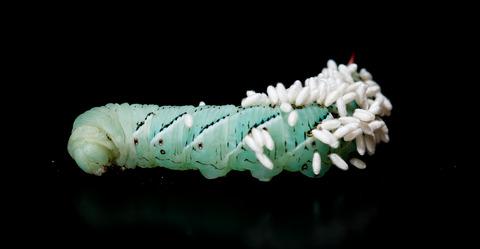当前位置:
X-MOL 学术
›
Funct. Ecol.
›
论文详情
Our official English website, www.x-mol.net, welcomes your feedback! (Note: you will need to create a separate account there.)
Differing thermal sensitivities in a host–parasitoid interaction: High, fluctuating developmental temperatures produce dead wasps and giant caterpillars
Functional Ecology ( IF 5.2 ) Pub Date : 2021-01-07 , DOI: 10.1111/1365-2435.13748 M. Elizabeth Moore 1 , Christina A. Hill 1 , Joel G. Kingsolver 1
中文翻译:

寄主与拟寄生虫相互作用的热敏感性不同:发育温度高,波动大,会产生死黄蜂和巨大的毛毛虫
更新日期:2021-03-08
Functional Ecology ( IF 5.2 ) Pub Date : 2021-01-07 , DOI: 10.1111/1365-2435.13748 M. Elizabeth Moore 1 , Christina A. Hill 1 , Joel G. Kingsolver 1
Affiliation

|
- Insect parasitoids, and the arthropod hosts they consume during development, are important ecological players in almost all environments across the globe. As ectothermic organisms, both parasitoid and host are strongly impacted by environmental temperature. If thermal tolerances differ between host insect and parasitoid, then the outcome of their interaction will be determined by the ambient temperature. As mean temperatures continue to rise and extreme temperatures become more frequent, we must determine the effect of high temperature stress on host–parasitoid systems to predict how they will fare in the face of climate change.
- The majority of studies conducted on host–parasitoid systems focus on either performance under constant temperature or a fixed metric of thermal tolerance (CTmax) for individual organisms. However, performance at constant temperatures is not predictive of performance under ecologically relevant, fluctuating temperatures and measurements of thermal thresholds provide little information regarding the effects of temperature throughout development. We address this by testing the effects of increasing mean temperature in both constant and fluctuating (±10°C) environments throughout development on the performance of the parasitoid wasp Cotesia congregata and its lepidopteran larval host, Manduca sexta.
- The growth of M. sexta was influenced by mean temperature, diurnal fluctuations and parasitization status. Caterpillar growth rate increased with increasing mean temperature, but decreased in response to diurnal fluctuations and parasitization by C. congregata wasps.
- Wasp survival decreased with increasing mean temperature and with diurnal fluctuations. The effect of diurnal fluctuations was stronger at higher mean temperatures. Diurnal fluctuations at our highest mean temperature treatment (30 ± 10°C) resulted in complete wasp mortality, and parasitized hosts displayed abnormal physiology, wherein they failed to exhibit wasp emergence, did not enter the prepupal stage, continued to feed and grew up to twofold larger than a normal, unparasitized caterpillar.
- Our results indicate hosts and parasitoids in this system have different thermal tolerances during development; the parasitoid wasp suffered complete mortality at a temperature regime that is mildly stressful for the unparasitized caterpillar host species. Our findings suggest C. congregata will suffer more severely under increasing temperatures than M. sexta, with cascading trophic and ecological effects.
中文翻译:

寄主与拟寄生虫相互作用的热敏感性不同:发育温度高,波动大,会产生死黄蜂和巨大的毛毛虫
- 昆虫寄生虫及其在发育过程中消耗的节肢动物宿主,在全球几乎所有环境中都是重要的生态参与者。作为外热生物,寄生虫和寄主都受到环境温度的强烈影响。如果寄主昆虫和拟寄生虫之间的热耐受性不同,那么它们相互作用的结果将取决于环境温度。随着平均温度的持续升高和极端温度的升高,我们必须确定高温胁迫对宿主-拟寄生物系统的影响,以预测它们在面对气候变化时的状况。
- 在宿主-拟寄生物系统上进行的大多数研究都针对单个生物体在恒定温度下的性能或固定的热耐受性度量(CT max)。但是,恒温下的性能不能预测与生态相关的性能,温度的波动和热阈值的测量几乎没有提供有关整个开发过程中温度影响的信息。我们通过测试在整个开发过程中恒定和波动(±10°C)环境中平均温度升高对寄生蜂黄蜂Cotesia congregata及其鳞翅目幼虫寄主Manduca sexta的性能的影响来解决此问题。
- 平均温度,昼夜波动和寄生状态都影响六分体的生长。毛虫生长速率随平均温度的升高而增加,但响应于昼夜波动和聚集的弓形虫黄蜂的寄生虫而降低。
- 黄蜂的存活率随平均温度的升高和昼夜波动而降低。在较高的平均温度下,昼夜波动的影响更大。在最高平均温度(30±10°C)下,昼夜波动导致黄蜂完全死亡,被寄生的寄主表现出异常的生理学,其中没有表现出黄蜂的出现,没有进入pu前期,继续进食并长大到比普通的无寄生毛虫大两倍。
- 我们的结果表明,该系统中的宿主和寄生虫在发育过程中具有不同的热耐受性。寄生虫黄蜂在未寄生虫毛虫寄主物种的温和压力下完全死亡。我们的研究结果表明C. congregata会更严重遭受下温度升高超过烟草天蛾,通过级联营养和生态效应。


























 京公网安备 11010802027423号
京公网安备 11010802027423号